Artillery in Canada (10) Newfoundland and Labrador: Argentia, Bay Bulls, Bay Roberts, Bell Island, Bonavista, Botwood, Brigus, and Burgeo
Artillery in Newfoundland & Labrador, Argentia, Bay Bulls, Bay Roberts, Bell Island, Bonavista, Botwood, Brigus, and Burgeo
For all official data concerning the Royal Regiment of Canadian Artillery, please click on the link to their website:
Royal Regiment of Canadian Artillery Website
The aim of this website is to locate, identify and document every historical piece of artillery preserved in Canada. Many contributors have assisted in the hunt for these guns to provide and update the data found on these web pages. Photos are by the author unless otherwise credited. Any errors found here are by the author, and any additions, corrections or amendments to this list of Guns and Artillery in Canada would be most welcome and may be e-mailed to the author at [email protected].
Note: Back in the day, artillery in Canada was referred to by its radio call sign "Sheldrake". It is now referred to by its "Golf" call sign. (Acorn)
Guns and Cannon
Those of us with an interest in old guns and cannon generally have to sort them out by size and purpose. If the weapon can be transported by manpower alone, and if it relies on direct hits to kill, then it is classed as a gun. If it takes more than one gunner to operate and is too heavy to be transported by manpower alone, and if its main purpose is to kill via shrapnel or concussion or to destroy obstacles, then it is a cannon. Even when they are not in action against a target that can shoot back, they can be extremely dangerous, particularly when at sea.

(IWM Photo, D 8888)
12-inch Mk. IV Howitzer manned by members of the Newfoundland Heavy Artillery Regiments in England in 1942. The tray on the right conveys the 750lb shells into the breech, as they are too heavy to be man-handled. They are raised into place by a crane. The cycinder driving the power rammer, introduced with the Mk II carriage, is visible on the right of the recoil cylinder above the barrel.

(IWM Photo H2838)
BL 9.2-inch Mk. II howitzers of the 57th (Newfoundland) Heavy Regiment, Royal Artillery, with Sir Winston Churchill during a tour of England's East Coast defences in 1940.
The 57th (Newfoundland) Heavy Regiment was based as Sussex in Southeast England under the command of Lieutenant-Colonel H.G. De Burgh. Divided into four Batteries (A, B, C, and D), this unit received six BL 9.2-inch Mk. II Howitzers on 5 June 1940. Resembling large mortars, each of these massive guns could fire 130-kilogram shells across a maximum distance of 9 kilometres. A, B, and C Batteries took two howitzers each, and by mid-June, D Battery had received two six-inch guns, which fired 45-kilogram shells over a 17-kilometre range.
On 15 November 1941, the 57th (Newfoundland) Heavy Regiment became the 166th (Newfoundland) Field Regiment equipped with 25-pounder C Mk. 2 QF Field Guns. In late February 1943, this unit had joined hostilities in Tunisia, where 24 Newfoundlanders were killed in action. The 166th joined the campaign in Italy in October 1943 and remained in there until the summer of 1945.
Shortly after the 166th (then 57th) Regiment departed Sussex in the summer of 1940, the RA formed the 59th (Newfoundland) Heavy Regiment, In July 1944 the 59th departed England for France to take part in the Battle of Normandy, where it fought using 7.2-inch howitzers and 155-millimetre guns against German forces. The 59th (Newfoundland) Heavy Regiment officially disbanded in August 1945, and the 166th followed suit in October.
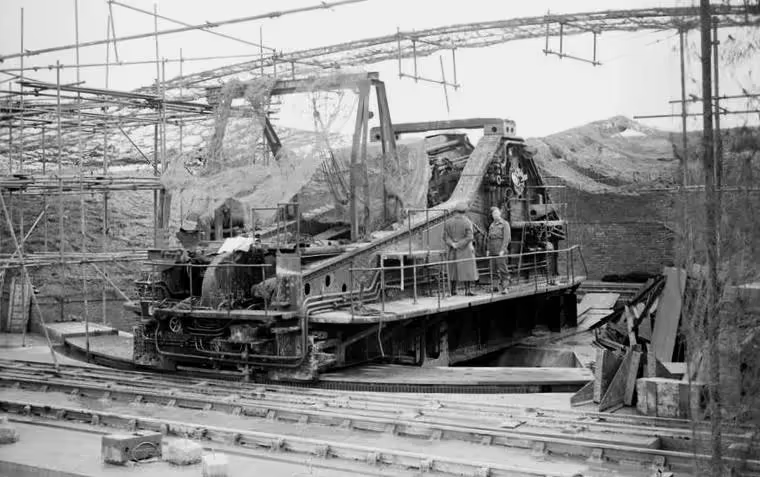
(IWM Photo, H7922)
Britain's Coastal Defences from 1939-45 included two 14-inch guns emplaced at St Margaret's, near Dover. The first gun, named 'Winnie', was in place by August 1940 and 'Pooh', the second gun, shown here, followed in February 1941. Both guns came from the reserve stock of guns for the 'King George V' class of battleships, and were mounted on modified naval barbettes. Manned by Royal Marine gunners, they were mostly employed in counter-battery fire with German batteries on the French coast. The Newfoundlander gunners were in the big leagues when it can to artillery.
Disposition of First World War Trophies in Newfoundland.
Following the Armistice in November 1918, individual Canadian soldiers and Canadian units began planning to send some type of war trophy back to Canada. In most cases the “trophy” being considered was a weapon captured on the battlefield. The Newfoundland Contingent would have had a similar interest in preserving a number of war trophies and likely had a representative in London who would have requested an allocation of a reasonable number of guns and other items for return to and preservation in Newfoundland. To decide what to bring back, the following had to be considered: Only trophies which were of a durable nature should be distributed to municipalities, public institutions, and military units; and, War trophies were the exclusive property of the Crown, and the receiving institution was responsible for keeping them in good repair and had no authority to dispose of them.
In 1920, the High Commissioner for Newfoundland went to England to petition for war trophies, and there's a detailed list in those papers, (Report of Disposition of War Trophies to Newfoundland, 19 Feb 1921), of the exact guns and ordinance granted to the country. There are accounts of these war trophies initially being left to languish in the elements until they were finally disbursed to communities. The people in St. John's reportedly complained about their neglect until the distributions began to take place. The trophies available were likely distributed based on the wartime enlistments in the Royal Newfoundland Regiment and the various land, sea and air services of the British forces.
The list of War Trophies (focused here on the artillery) allocated and distributed throughout Newfoundland included the following kit:
Report of Disposition of War Trophies to Newfoundland, 19 Feb 1921
Article Sent to Date Status
1 Light German Field Gun (7.7-cm FK96) Grand Falls 31 Dec 1920 unknown
1 Light German Field Gun (7.7-cm FK96) Trinity 31 Dec 1920 Preserved
1 Light German Field Gun (7.7-cm FK96) Bonavista 31 Dec 1920 Preserved
1 Light German Field Gun (7.7-cm FK96) Placentia 31 Dec 1920 Preserved
1 Heavy Trench Mortar on Carriage Heart’s Content 14 Jan 1921 unknown
1 Heavy Trench Mortar on Carriage (17-cm mMW) Catalina 14 Jan 1921 Preserved
1 Heavy Trench Mortar on Carriage Harbor Grace 14 Jan 1921 unknown
(This may be the 24-cm sMW preserved at Stephenville Crossing)
1 Heavy Trench Mortar on Carriage (7.58-cm leMW) Bay Roberts 14 Jan 1921 Preserved
1 Heavy Trench Mortar on Carriage (7.58-cm leMW) St. Georges 14 Jan 1921 Preserved
1 Heavy Trench Mortar on Carriage (17-cm mMW) Harbor Breton 14 Jan 1921 Preserved
1 Heavy Trench Mortar on Carriage (17-cm mMW) Botwood 14 Jan 1921 Preserved
2 Heavy German Howitzers (15 cm sFH 13) Colonial Building, St. Johns 30 Dec 1920
(One of these two large guns is preserved in front of the Legion, the other has been lost)
1 Heavy German Field Gun (10-cm K17) Bannerman Park, St. Johns 30 Dec 1920 Preserved
1 Heavy German Field Gun (10-cm K17) Victoria Park, St. Johns 30 Dec 1920 Preserved
1 British Whippet Tank, sent to the Dept of Public Works, St. Johns 30 Dec 1920 unknown
34 German Machine Guns in storage.
28 German Granatenwerfer Trench Mortars in storage
1 German Light Trench Mortar on bed in storage
(One German 7.58-cm leMW is preserved at Carbonear)
10 German Light Trench Mortars on carriage in storage
7 German Heavy Trench Mortars on bed in storage
2 German Heavy Trench Mortars on carriage in storage
2 German Heavy Trench Mortars on Carriage in storage
(One German 24-cm Flügelminenwerfer is preserved at Greenspond)
There was also a German Zeppelin Frame, Engine and Gondola in storage
The War Trophies on display throughout Newfoundland may have come from a number of great parks set aside by the British for the assembly of captured enemy equipment. They would most likely have been captured on the battlefields of France late in 1918, during the advances of the "Hundred Days Offensive" which the Royal Newfoundland Regiment took part in, and in which Thomas Ricketts became the youngest soldier of the war to win the Victoria Cross.
Communities with a few enlistments may have received a German 7.62-mm machinegun (MG08 or MG08/15), or a light trench mortar (7.58-cm leMWs went to Bay Roberts and St. Georges for example). Larger numbers of enlistments meant a bigger trophy was allocated, (heavy 17-cm mMW trench mortars went to Botwood and Catalina). Stephenville, a larger community, currently has a 25-cm heavy trench mortar which may have been allocated to another community such as Harbor Grace. The larger communities received field guns, such as the four 7.7-cm FK 96s that went to Bonavista, Grand Falls, Placentia and Trinity. St Johns received the lion's share of big guns with two 10-cm K17 field guns and two 15-cm sFH howitzers (one of which was fairly recently buried in a landfill). Clearly there was a great deal of respect for these trophies which often served as community war memorials, as nearly all the major guns appear to have survived.
Confirmation of the status of the guns not listed here would be most welcome.
Newfoundland and Labrador
Argentia, Fort McAndrew
Argentia 282 Coastal Defence Battery
How Rare Are Argentia 282 Guns? VERY RARE!
Article by Anita O'Keefe
United States Army Coast Artillery Corps troops were first deployed to Argentia in early 1941. After the US entered the Second World War following the attack on Pearl Harbor on 7 December 1941, construction began on two batteries (Battery 281 and 282 in Argentia) two 6-inch each began in January 1942 and was completed in October 1942. Their job was to provide protection for the Argentia Naval Station from enemy ships and U-boat attacks. Although they were never used against an enemy vessel, they serve as a reminder of the fear that the Americans had that an attack on the Air Base was plausible.
By the end of 1942, Battery 281 and Battery 282, were among the other Batteries recorded as being in the Argentia area. Both the 281 and 282 Batteries had 2 guns each. The rapid-fire gun type was a 6-inch gun M1903 (Serial No. 13) Gun Battery 282 Emplacement, Shielded Barbette (SBC) M1 No. 45, Erie manufactured by Watervliet.
Battery 281 location is recorded as being 47˚17’26” N and 53˚58’46” W. On the South Side, although the two guns for this site were removed and relocated to the United States, the bunker remains in place along with the concrete based platforms for the guns.
Battery 282 location is 47˚16’25” N and 53˚59’22” W. The bunker and guns remain at this site as they were when first installed. They can be seen and accessed from the road, and you can drive to the site by taking the dirt road to your left after you go under the overpass on the South Side of Argentia.
Postwar, circa 1946 the coastal defence batteries were inactivated. The 6-inch guns of Batteries 281 and 282 survive. Battery 282’s guns are still in place in Argentia. In 1993 Battery 281’s pair of guns and their mountings were shipped to Fort Columbia in Washington state, USA, and renamed.
Only four of these guns remain in the world, two at Fort Columbia in Battery 246 which were originally from Argentia (former 281 guns) and two located at the former Fort McAndrew Base in Battery 282 in Argentia, Newfoundland and Labrador. Of the 87 planned, only 45 were completed and many of those were not completed until late in the war (1944-1945).
The 6” guns fired a 105-pound amour-piercing projectile with a range of over 15 miles at a rate of up to 5 rounds per minute. The gun crews were protected by a thick shield around the gun. These 6” Second World War coastal gun batteries were designed to replace obsolete Endicott Period Batteries.
Batteries 281 and 282 were reinforced concrete, earth covered coastal batteries that were built in Fort McAndrew. Argentia 282 Coastal Defence Battery is located on a hill overlooking Placentia Bay and the former American Base of Fort McAndrew in Argentia. Along with the main underground structure, two associated guns are mounted outside the bunker, one on each side of it. These guns were shielded long-range carriages and the batteries were made with reinforced concrete covered in earth, housing magazines and fire control equipment.
Heritage status has been awarded both municipally and provincially, and the designation encompasses a portion of the underground and above ground fortification, including the two original artillery guns.
282 Coastal Defence Battery has aesthetic value as its design and construction technique are rare in the province. Known as the “200 Series” bunker, this underground fortification may also be the only one of its kind remaining with its original artillery guns in place. While many such bunkers were constructed along the coast of Newfoundland and Labrador during the Second World War, most of these have been dismantled or have fallen into major disrepair. Built of concrete, the bunker is covered with soil and vegetation, blending into the landscape as its original design intended.
In August 2024, as part of the Hike Placentia Trails Project, this heritage designated site was clear-cut which opened up the area and the guns were given a nice new fresh coat of paint. This important gun site and bunker structure will be a highlighted feature along the newly developed trail system in Argentia.
The guns in Argentia are rare survivors of a once-common type of coastal artillery. Their preservation offers significant historical value, and they are among the remaining examples of these powerful weapons used to protect key military installations during the Second World War.
The battery (including guns) was designateda provincial Registered Heritage Structure by Heritage Newfoundland on 7 October 2005.
The battery (including guns) was designated a municipal heritage site by the Town of Placentia on 19 August 2006.



(Tom OKeefe Photos)
6-inch Gun Model M1903, (Serial No. 8), Gun Battery 282 Emplacement, Shielded Barbette (SBC) M1 No. 44, Erie, manufactured by Watervliet. Located on Hill 195 on the south side of town.


(Tom O'Keefe Photos)

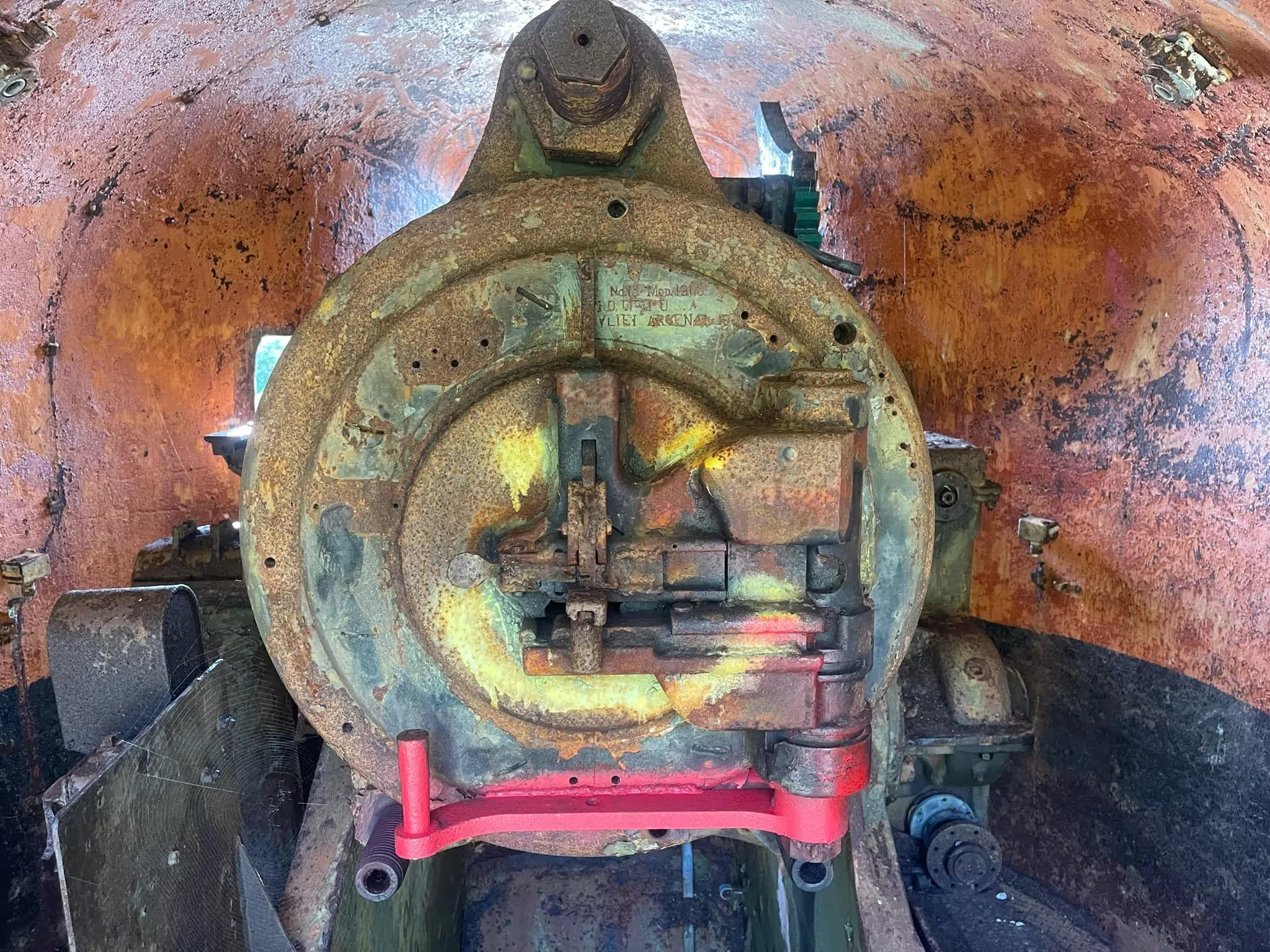

(Anita O'Keefe Photos)
6-inch Gun Model M1903, (Serial No. 13), Gun Battery 282 Emplacement, Shielded Barbette (SBC) M1 No. 45, Erie, manufactured by Watervliet.
https://en.wikipedia.org/wiki/Harbor_Defenses_of_Argentia_and_St._John%27s
Battery 281's two M1903 six-inch guns and mountings were shipped to Fort Columbia in Washington state in 1993.


(Joe Mabel Photos)

(Orange Suede Sofa Photo)
6-inch coastal artillery gun at Fort Columbia state park, on a Second World War mounting, M1903 gun on shielded barbette carriage M1.
In 1993, the park received a pair of M1903 6-inch guns that were transferred to Battery 246 from the former Fort McAndrew, Naval Station Argentia, Newfoundland, Canada.
Exhibits at the Fort Columbia Interpretive Center focus on the fort's history, early explorers and pioneer history. The Commanding Officers Quarters is decorated with turn-of-the-century furnishings. The park grounds feature three artillery batteries and two coastal artillery guns. There are picnicking facilities and 5 miles (8.0 km) of hiking trails that work their way up Scarborough Hill. Two historic homes, the Steward's House and Scarborough House, are offered for rental. The park is one of several state parks and sites in Washington and Oregon that make up the Lewis and Clark National Historical Park.
Bay Bulls




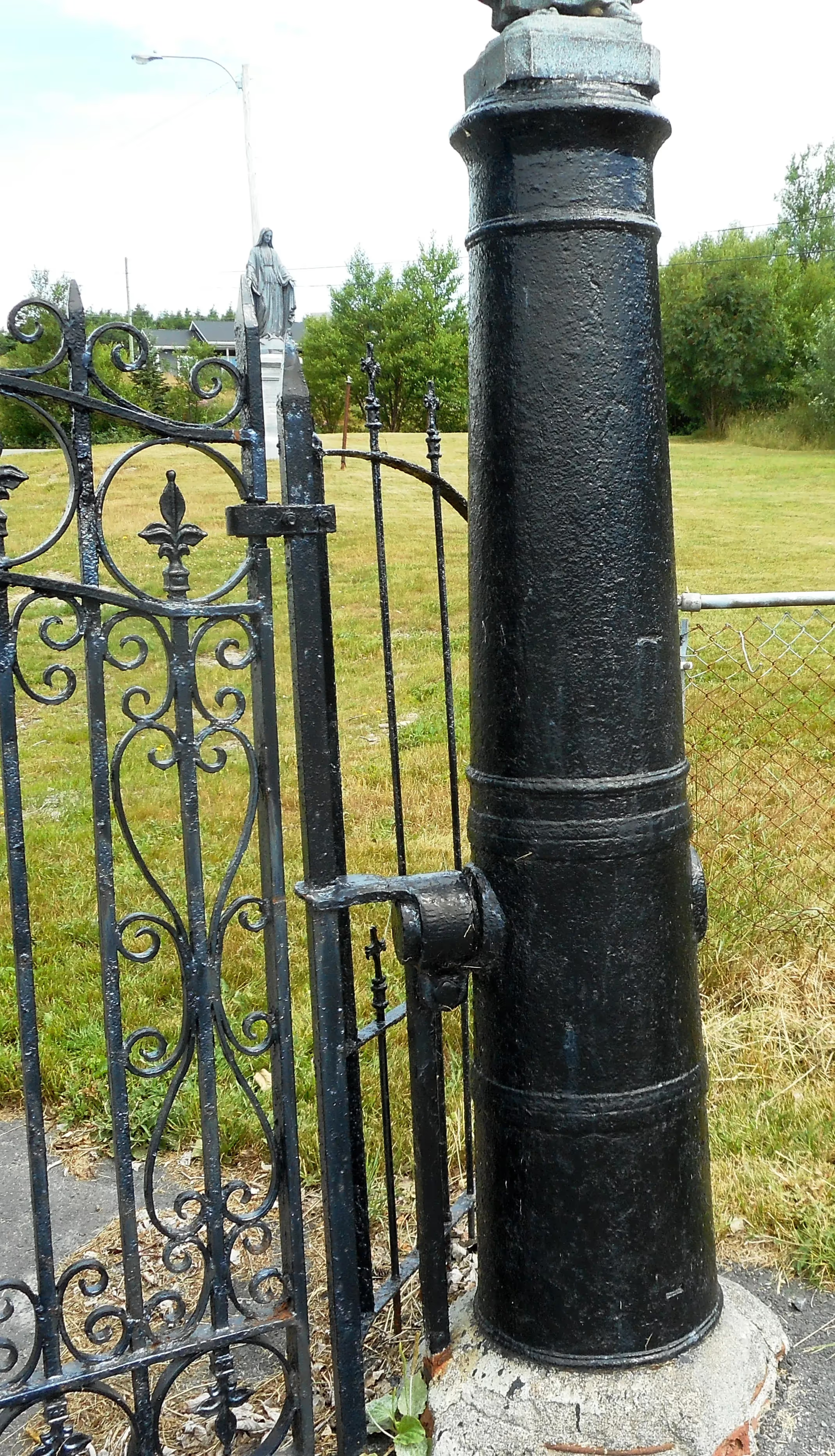
(Terry Honour Photos)
Cast Iron possible 9-pounder Smoothbore Muzzleloading Gun, weight unknown, no visible markings, broken right trunnion, No. 1 of 4 guns mounted upright on a concrete base as part of the front gate to the Roman Catholic Church. A religious figure/statue with the head missing is set on top.
Cast Iron Blomefield 18-pounder Smoothbore Muzzleloading Gun, weight unknown, The Carron Company of Falkirk, Scotland (Serial No. possibly 60051, CARRON, 1805) on left trunnion, (18P) on right trunnion, King George III cypher, broad arrow mark, No. 2 of 4 guns mounted upright on a concrete base as part of the front gate to the Roman Catholic Church, with a religious figure/statue set on top.
Cast Iron Blomefield 18-pounder Smoothbore Muzzleloading Gun, weight unknown, The Carron Company of Falkirk, Scotland (Serial No. unknown, CARRON, 1805) on left trunnion, (18P) on right trunnion, King George III cypher, broad arrow mark, No. 3 of 4 guns mounted upright on a concrete base as part of the front gate to the Roman Catholic Church, with a religious figure/statue set on top.
Cast Iron possible 9-pounder Smoothbore Muzzleloading Gun, weight unknown, no visible markings, broken left trunnion, No. 4 of 4 guns mounted upright on a concrete base as part of the front gate to the Roman Catholic Church. A religious figure/statue is set on top.
Cast Iron 9-pounder Smoothbore Muzzleloading Gun, weight 29-3-1 (3,333 lbs), (Serial No. 589), King George III cypher, broad arrow mark, half buried in the ground. Discovered buried during road work in the 1970s. Gun Hill.



(James Stanton Photo)
Possibly a Carronade that may have come up from HMS Sapphire.
The wreck of HMS Sapphire, a 32-gun fifth rate warship of the Royal Navy, built in 1675, was cornered in Bay Bulls Harbour by a French squadron in Aug-Sep 1696. Her master, Captain Thomas Cleasby, fearing that the French would capture the ship, scuttled her on 11 Sep, and escaped across land to the colony of Ferryland. Four of the ship’s cannon are visible underwater.
The area of the wreck and surrounding debris fields, including any and all remaining in-situ artifacts, has been protected as a Provincial Historic Site, and was listed on the Canadian Register of Historic Places on 23 August 2005
Bay Roberts

(Maxwell J. Toms Photo)



(Terry Honour Photos)
German First World War 17-cm mittlerer Minenwerfer (17-cm mMW), medium trench mortar (Serial Nr. unknown).
Bell Island

(Daniel Rees Photo)
4.7-inch QF Mk. IV* "Star" Gun, (Serial No. 1173), No. 1 of 2, on a Central Pivot Mount Mk I. (DND Photo)
4.7-inch QF Mk. IV* "Star" Gun, (Serial No. 1174), No. 2 of 2, on a Central Pivot Mount Mk I.
These two 4.7-inch quick-firing guns were sent to Bell Island early in the war, and remain located at Beach Hill, at the top of the cliff above the ferry terminal. The extant battery is now a memorial to the Second World War. These guns were fired in anger during U-boat attacks early in the Second World War but could not be brought to bear on the target because they could not be lowered enough. Bell Island was the location of strategic iron ore deposits (the mines were closed in 1966). On 5 Sep 1942 two ore boats the S.S. Lord Strathcona and the S.S. Saganaga, were in anchorage and sunk by the German U-boat U-513, which had slipped into the bay during the night. The shore battery, manned by the Newfoundland militia, didn't see or hit the submarine, and the rounds landed on a farm across the bay. Two months later, on 2 Nov, the German U-boat U-518 torpedoed the S.S. Rose Castle and the Free-French freighter PLM 27. Again the shore battery fired at an unseen target. Bell Island has the distinction of being the site of the only coast artillery guns fired in defence of North America during the Second World War.

(Library and Archives Canada Photo, MIKAN No. 3630157)
SS Rose Castle. A Royal Canadian Air Force plane took this photo of Rose Castle as she left Sydney, Nova Scotia in the first convoy (BW 1) to Bell Island, Newfoundland on September 11, 1942. The Royal Canadian Navy instituted convoys to protect ore and coal ships sailing between Sydney and Bell Island in the week following the first U-boat attack at Bell Island on 5 September. The crew of Rose Castle were Merchant Navy sailors mostly from Nova Scotia and Newfoundland, with a few from Britain. Twenty-four men died when the ship was sunk on November 2, 1942, including six from Newfoundland. Nineteen crewmates survived.
A US Army Coastal artillery unit had many portable guns and at least one building at Holyrood for a barracks and storage. There was also a gun emplacement in the Cherry Lane section of Manuels. A German U-boat fired a torpedo at the mouth of St. John’s Harbour, and perhaps two at the loading dock in Bell Island. (Nelson Sherren)
Bonavista



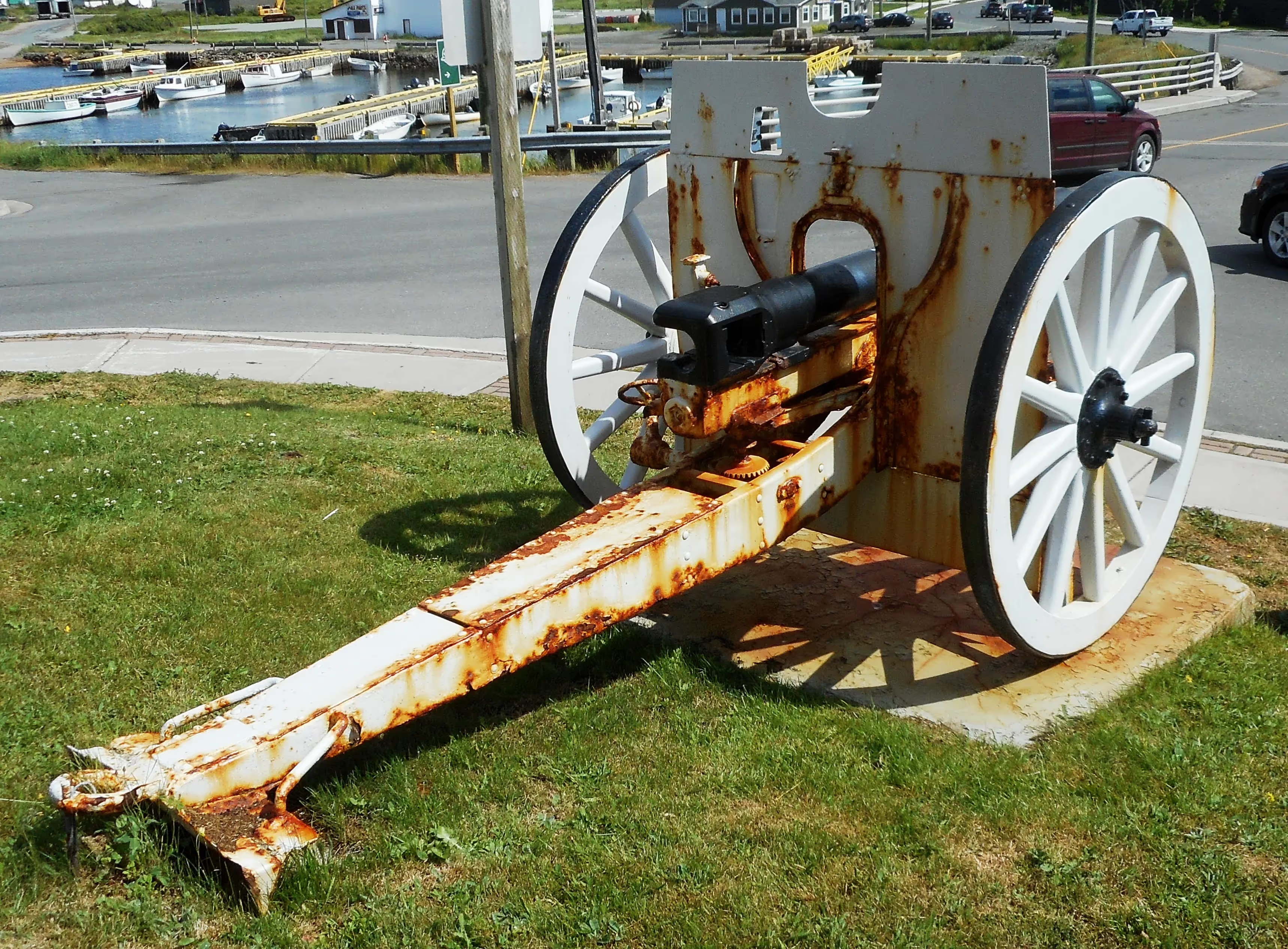

(Terry Honour Photos)
German First World War 7.7-cm Feldkanone 96 neuer Art (7.7-cm FK 96 n.A.), Field Gun (Serial Nr. unknown), in front of the courthouse. Rebuilt in 2007 by Jim Steinhauer and Nelson Sherren. The gun has new wheels and was cleaned and the metal work was restored and painted with epoxy paint. According to a "Report of Disposition of War Trophies to 19 February 1921 (Journal of the House of Assembly of Newfoundland)", a captured German Field Gun (likely an FK 96) was sent to Bonavista on 31 Dec 1920. This is most likely the same gun.
.avif)
(John Mundster Photo)
Muckbeggar Plantation with SBMLs in front.
.avif)
(John Mundster Photo)
Cast Iron possibly 32-pounder 17-cwt Smoothbore Muzzleloading Carronade with a broken breeching ring, weight unknown, markings corroded, mounted on a wooden stand, No. 1 of 2.
.avif)
(John Mundster Photo)
Cast Iron possibly 32-pounder 17-cwt Smoothbore Muzzleloading Carronade with a Blomefield pattern breeching ring, weight unknown, markings corroded, mounted on a wooden stand, No. 2 of 2.

(Terry Honour Photo)
.avif)
(John Mundster Photo)
Cast Iron possibly 4-pounder Smoothbore Muzzleloading Gun, heavily corroded, no visible markings, mounted on a wooden stand.
Botwood

German First World War 17-cm mittlerer Minenwerfer (17-cm mMW), Trench mortars and other German guns captured by Canadians, Cambrai, Nov 1918. (Library and Archives Canada Photo, MIKAN No. 3397968)



(Chris Charland Photos)
German First World War 17-cm mittlerer Minenwerfer (17-cm mMW), medium trench mortar (Serial Nr. 6061), 1917, in front of the Royal Canadian Legion.
Brigus
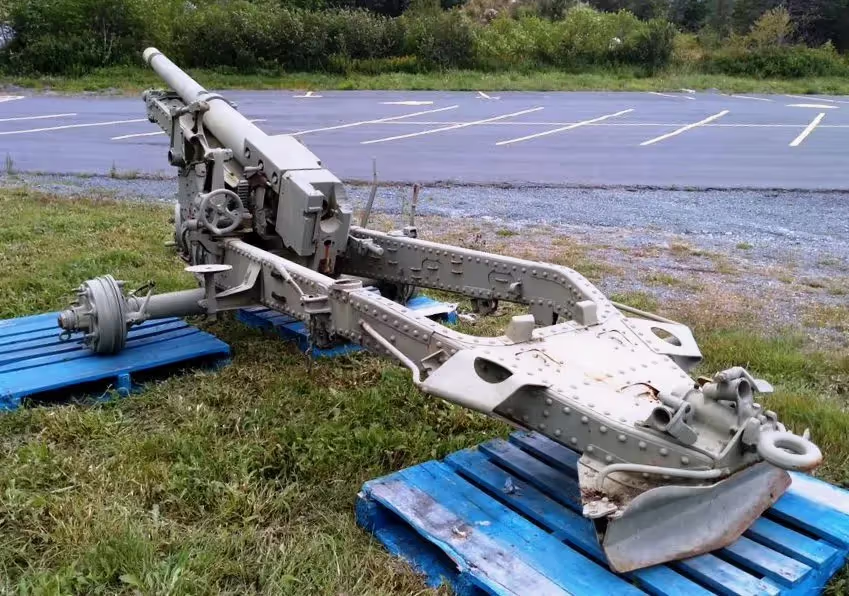
(Gary Kett Photo)

25-pounder field gun Mk.1, dated 1941, Reg No. L / 803. The gun is missing its wheels, and currently stands in front of Royal Canadian Legion Branch No. 65. Volunteers are seeking parts, including wheels to restore this gun.
Burgeo
German First World War 17-cm mittlerer Minenwerfer, (17-cm mMW), medium trench mortar (Serial Nr. unknown), standing in front of the local museum at 6 Centennial Rd.





